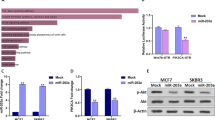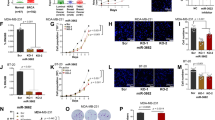Abstract
The genes encoding microRNAs of the human miR-200 family map to fragile chromosomal regions and are frequently downregulated upon tumor progression. Although having been reported to regulate epithelial-to-mesenchymal transition and transforming growth factor-beta-driven cell invasion, the role of the miR-200 family in EGF-driven breast cancer cell invasion, viability, apoptosis and cell cycle progression is still unknown. In particular, there is no study comparing the roles of the two clusters of this miRNA family. In this study, we show for the first time that miR-200 family members differentially regulate EGF-driven invasion, viability, apoptosis and cell cycle progression of breast cancer cells. We showed that, all miR-200 family members regulate EGF-driven invasion, with the miR-200bc/429 cluster showing stronger effects than the miR-200a/141 cluster. Furthermore, expression of the miR-200a/141 cluster results in G1 arrest supported by increased p27/Kip1 and decreased cyclin dependent kinase 6 expression. In contrast, expression of the 200bc/429 cluster decreases G1 population and increases G2/M phase, in line with the observed reduction of p27/Kip1 and upregulation of the inhibitory phosphorylation of Cdc25C, respectively. To test the hypothesis that phenotypical differences observed between the two clusters are caused by differential targeting spectrums, we performed genome-wide microarray profiling in combination with gain-of-function studies. This identified phospholipase C gamma 1 (PLCG1), which was downregulated only by the miR-200bc/429 cluster, as a potential candidate contributing to these phenotypical differences. Luciferase reporter assays validated PLCG1 as a direct functional target of miR-200bc/429 cluster, but not of miR-200a/141 cluster. Finally, loss of PLCG1 in part mimicked the effect of miR-200bc/429 overexpression in viability, apoptosis and EGF-driven cell invasion of breast cancer cells. Our results suggest that the miR-200 family has a tumor-suppressor function by negatively regulating EGF-driven cell invasion, viability and cell cycle progression in breast cancer.
This is a preview of subscription content, access via your institution
Access options
Subscribe to this journal
Receive 50 print issues and online access
$259.00 per year
only $5.18 per issue
Buy this article
- Purchase on SpringerLink
- Instant access to full article PDF
Prices may be subject to local taxes which are calculated during checkout







Similar content being viewed by others
References
Adam L, Zhong M, Choi W, Qi W, Nicoloso M, Arora A et al. (2009). miR-200 expression regulates epithelial-to-mesenchymal transition in bladder cancer cells and reverses resistance to epidermal growth factor receptor therapy. Clin Cancer Res 15: 5060–5072.
Arumugam T, Ramachandran V, Fournier KF, Wang H, Marquis L, Abbruzzese JL et al. (2009). Epithelial to mesenchymal transition contributes to drug resistance in pancreatic cancer. Cancer Res 69: 5820–5828.
Baffa R, Fassan M, Volinia S, O'Hara B, Liu CG, Palazzo JP et al. (2009). MicroRNA expression profiling of human metastatic cancers identifies cancer gene targets. J Pathol 219: 214–221.
Bagchi A, Mills AA . (2008). The quest for the 1p36 tumor suppressor. Cancer Res 68: 2551–2556.
Bartel DP . (2009). MicroRNAs: target recognition and regulatory functions. Cell 136: 215–233.
Browaeys-Poly E, Perdereau D, Lescuyer A, Burnol AF, Cailliau K . (2009). Akt interaction with PLC (gamma) regulates the G(2)/M transition triggered by FGF receptors from MDA-MB-231 breast cancer cells. Anticancer Res 29: 4965–4969.
Chen P, Xie H, Sekar MC, Gupta K, Wells A . (1994). Epidermal growth factor receptor-mediated cell motility: phospholipase C activity is required, but mitogen-activated protein kinase activity is not sufficient for induced cell movement. J Cell Biol 127: 847–857.
Citri A, Yarden Y . (2006). EGF-ERBB signalling: towards the systems level. Nat Rev Mol Cell Biol 7: 505–516.
Cochrane DR, Howe EN, Spoelstra NS, Richer JK . (2010). Loss of miR-200c: a marker of aggressiveness and chemoresistance in female reproductive cancers. J Oncol 2010 (doi:10.1155/2010/821717).
DiPaola RS . (2002). To arrest or not to G(2)-M Cell-cycle arrest: commentary re: A K. Tyagi et al., Silibinin strongly synergizes human prostate carcinoma DU 145 cells to doxorubicin-induced growth inhibition, G(2)-M arrest, and apoptosis; 2002,Clin Cancer Res, 8: 3512-3519. Clin Cancer Res 8: 3311–3314.
Esquela-Kerscher A, Slack FJ . (2006). Oncomirs—microRNAs with a role in cancer. Nat Rev Cancer 6: 259–269.
Gregory PA, Bert AG, Paterson EL, Barry SC, Tsykin A, Farshid G et al. (2008). The miR-200 family and miR-205 regulate epithelial to mesenchymal transition by targeting ZEB1 and SIP1. Nat Cell Biol 10: 593–601.
Huber W, von Heydebreck A, Sultmann H, Poustka A, Vingron M . (2002). Variance stabilization applied to microarray data calibration and to the quantification of differential expression. Bioinformatics 18 (Suppl 1): S96–S104.
Hyun S, Lee JH, Jin H, Nam J, Namkoong B, Lee G et al. (2009). Conserved MicroRNA miR-8/miR-200 and its target USH/FOG2 control growth by regulating PI3K. Cell 139: 1096–1108.
Lewis BP, Burge CB, Bartel DP . (2005). Conserved seed pairing, often flanked by adenosines, indicates that thousands of human genes are microRNA targets. Cell 120: 15–20.
Li S, Wang Q, Wang Y, Chen X, Wang Z . (2009). PLC-gamma1 and Rac1 coregulate EGF-induced cytoskeleton remodeling and cell migration. Mol Endocrinol 23: 901–913.
Liu Q, Fu H, Sun F, Zhang H, Tie Y, Zhu J et al. (2008). miR-16 family induces cell cycle arrest by regulating multiple cell cycle genes. Nucleic Acids Res 36: 5391–5404.
Livak KJ, Schmittgen TD . (2001). Analysis of relative gene expression data using real-time quantitative PCR and the 2(-Delta Delta C(T)) Method. Methods 25: 402–408.
Ma L, Teruya-Feldstein J, Weinberg RA . (2007). Tumour invasion and metastasis initiated by microRNA-10b in breast cancer. Nature 449: 682–688.
Markova B, Albers C, Breitenbuecher F, Melo JV, Brummendorf TH, Heidel F et al. (2010). Novel pathway in Bcr-Abl signal transduction involves Akt-independent, PLC-gamma1-driven activation of mTOR/p70S6-kinase pathway. Oncogene 29: 739–751.
Parkin DM, Bray F, Ferlay J, Pisani P . (2005). Global cancer statistics, 2002. CA Cancer J Clin 55: 74–108.
Peng CY, Graves PR, Thoma RS, Wu Z, Shaw AS, Piwnica-Worms H . (1997). Mitotic and G2 checkpoint control: regulation of 14–3–3 protein binding by phosphorylation of Cdc25C on serine-216. Science 277: 1501–1505.
Raver-Shapira N, Marciano E, Meiri E, Spector Y, Rosenfeld N, Moskovits N et al. (2007). Transcriptional activation of miR-34a contributes to p53-mediated apoptosis. Mol Cell 26: 731–743.
Sahin O, Frohlich H, Lobke C, Korf U, Burmester S, Majety M et al. (2009). Modeling ERBB receptor-regulated G1/S transition to find novel targets for de novo trastuzumab resistance. BMC Syst Biol 3: 1.
Sahin O, Lobke C, Korf U, Appelhans H, Sultmann H, Poustka A et al. (2007). Combinatorial RNAi for quantitative protein network analysis. Proc Natl Acad Sci USA 104: 6579–6584.
Sala G, Dituri F, Raimondi C, Previdi S, Maffucci T, Mazzoletti M et al. (2008). Phospholipase Cgamma1 is required for metastasis development and progression. Cancer Res 68: 10187–10196.
Sato Y, Kobayashi H, Suto Y, Olney HJ, Davis EM, Super HG et al. (2001). Chromosomal instability in chromosome band 12p13: multiple breaks leading to complex rearrangements including cytogenetically undetectable sub-clones. Leukemia 15: 1193–1202.
Saydam O, Shen Y, Wurdinger T, Senol O, Boke E, James MF et al. (2009). Downregulated microRNA-200a in meningiomas promotes tumor growth by reducing E-cadherin and activating the Wnt/beta-catenin signaling pathway. Mol Cell Biol 29: 5923–5940.
Smyth GK . (2004). Linear models and empirical bayes methods for assessing differential expression in microarray experiments. Stat Appl Genet Mol Biol 3: Article 3.
Tavazoie SF, Alarcon C, Oskarsson T, Padua D, Wang Q, Bos PD et al. (2008). Endogenous human microRNAs that suppress breast cancer metastasis. Nature 451: 147–152.
Thomson S, Buck E, Petti F, Griffin G, Brown E, Ramnarine N et al. (2005). Epithelial to mesenchymal transition is a determinant of sensitivity of non-small-cell lung carcinoma cell lines and xenografts to epidermal growth factor receptor inhibition. Cancer Res 65: 9455–9462.
Xia H, Ng SS, Jiang S, Cheung WK, Sze J, Bian XW et al. (2010). miR-200a-mediated downregulation of ZEB2 and CTNNB1 differentially inhibits nasopharyngeal carcinoma cell growth, migration and invasion. Biochem Biophys Res Commun 391: 535–541.
Yauch RL, Januario T, Eberhard DA, Cavet G, Zhu W, Fu L et al. (2005). Epithelial versus mesenchymal phenotype determines in vitro sensitivity and predicts clinical activity of erlotinib in lung cancer patients. Clin Cancer Res 11: 8686–8698.
Acknowledgements
This work was supported in part by the National Genome Research Network (Contract No. 01GS0864) of the Federal Ministry of Education and Research (BMBF) and by Wilhelm-Sander Stiftung (Contract No. 2009.051.1). JDZ is supported by the DKFZ International PhD Program. We thank Moritz Küblbeck, Christian Schmidt and Ute Ernst for their excellent technical assistance.
Author information
Authors and Affiliations
Corresponding author
Ethics declarations
Competing interests
The authors declare no conflict of interest.
Additional information
Supplementary Information accompanies the paper on the Oncogene website
Rights and permissions
About this article
Cite this article
Uhlmann, S., Zhang, J., Schwäger, A. et al. miR-200bc/429 cluster targets PLCγ1 and differentially regulates proliferation and EGF-driven invasion than miR-200a/141 in breast cancer. Oncogene 29, 4297–4306 (2010). https://doi.org/10.1038/onc.2010.201
Received:
Revised:
Accepted:
Published:
Issue Date:
DOI: https://doi.org/10.1038/onc.2010.201



